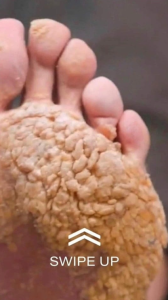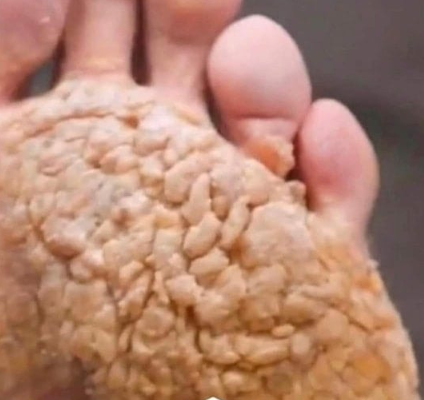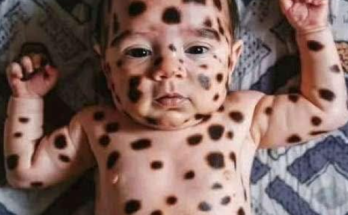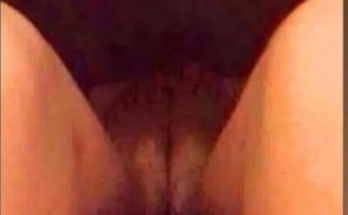A Closer Look at Severe Skin Conditions Like This
When we look at skin that has become thickened, cracked, and covered in plaque-like lesions, it often signals the skin’s natural renewal process has gone into overdrive. The skin normally sheds old cells and replaces them with new ones every 28 to 30 days. But in certain conditions, this cycle speeds up dramatically, causing a rapid buildup of dead skin cells that harden and form scales, bumps, or plaques.
On a foot, where pressure, friction, and exposure are constant, these buildups can become extreme. The image evokes strong reactions because it challenges our sense of what skin “should” look like and makes us realize how debilitating such a condition can be for someone living with it.
Possible Causes of This Appearance
-
Psoriasis
Psoriasis is a chronic autoimmune disease where the body’s immune system mistakenly attacks healthy skin cells, speeding up turnover. The result is thick, red, scaly patches. On the feet, this is called palmoplantar psoriasis. It can make walking painful and lead to social stigma. -
Plantar Warts (Verrucae Plantaris)
Caused by the human papillomavirus (HPV), plantar warts often form clusters that look rough, grainy, and raised. In severe cases, multiple warts can merge, covering large portions of the sole or toes with thick, cauliflower-like growths. -
Ichthyosis
A rare genetic skin disorder where the skin looks like fish scales. The body cannot shed old skin cells properly, so thick plates or scales form. Severe cases may cover feet, hands, and other areas with cracked, painful layers. -
Hyperkeratosis
This refers to an overproduction of keratin (the protein in skin, hair, and nails). It can happen due to constant friction, infection, or systemic conditions. On feet, hyperkeratosis often appears as extreme calluses, but sometimes it can look disease-like if widespread. -
Severe Fungal Infections
Certain fungal infections, when untreated, can create thick, crusty, scaling skin that spreads across the toes and sole. Though usually less dramatic than the image, chronic infections can reach this severity.
The Emotional and Social Impact
Living with skin that looks like this is not just a physical burden but a deep emotional challenge. Skin is one of the first things people notice, and when it appears unusual, others may stare, whisper, or recoil. For the person affected, this can create feelings of shame, embarrassment, or isolation. They may avoid wearing sandals, going swimming, or even participating in social activities.
Many patients with severe skin conditions report depression, anxiety, or lowered self-esteem. They are often frustrated not just by the condition itself but by the reactions of others who assume it’s contagious or caused by “bad hygiene,” when in reality, most of these conditions are autoimmune or genetic in nature.
The Physical Burden
On feet especially, these conditions are not just cosmetic. They can be painful. Walking on cracked, scaly skin feels like stepping on rocks with every movement. Shoes may rub, causing bleeding. Infections can develop in open cracks. Even simple tasks like standing for long periods or walking short distances can become exhausting.
What Scientists Say About Treatment
Science has made progress in treating severe dermatological conditions, though many remain chronic and incurable. Treatments aim to reduce symptoms, manage flare-ups, and improve quality of life.
-
Topical Treatments
-
Steroid creams reduce inflammation.
-
Salicylic acid helps peel away thickened skin.
-
Coal tar preparations slow skin cell growth.
-
-
Systemic Medications
-
Methotrexate or cyclosporine suppress the immune system for severe psoriasis.
-
Biologics (like adalimumab, etanercept, ustekinumab) target specific immune pathways and have revolutionized psoriasis care.
-
-
Procedural Treatments
-
Cryotherapy (freezing) can remove plantar warts.
-
Laser therapy and phototherapy (UV light) can reduce plaques and scaling.
-
In rare cases, surgery may be used to remove stubborn growths.
-
-
Lifestyle and Home Care
-
Moisturizers with urea or lactic acid keep skin soft.
-
Warm soaks help loosen thickened skin.
-
Protective footwear reduces pressure on sensitive areas.
-
Why This Strikes People So Strongly
Images like this go viral because they shock the viewer. Skin conditions challenge cultural ideals of beauty, hygiene, and health. What is normal for one person can be horrifying for another. But behind the image is a real human being dealing with pain, stigma, and sometimes lifelong struggle.
It is worth remembering that skin diseases are among the most common medical conditions worldwide. According to the World Health Organization, one in three people will experience a skin condition at some point in their lives. Severe cases, like what appears in this photo, may be rare—but they are real, and they deserve empathy, not judgment.
The Importance of Awareness
By talking about conditions like psoriasis, ichthyosis, and plantar warts openly, society can help reduce stigma. People living with severe skin conditions need compassion and medical care, not ridicule. Social awareness can encourage earlier treatment, better funding for research, and stronger support systems for those affected.
It also helps others realize that skin health is connected to overall health. Autoimmune diseases, infections, and genetic disorders often show their first signs on the skin. Paying attention to skin changes and seeking medical advice early can make a huge difference in outcomes.
Conclusion
The foot in the image does not represent “acne” in the traditional sense but rather a severe skin disorder involving thickened, scaly plaques—possibly psoriasis, ichthyosis, plantar warts, or hyperkeratosis. Scientists understand that while these conditions can look shocking, they are often not contagious but rather autoimmune, viral, or genetic in origin.
The person living with it likely experiences daily pain, mobility challenges, and emotional struggles due to the stigma of having visibly affected skin. Science offers treatments that can help manage the condition, but many cases remain chronic, requiring lifelong care.
Ultimately, images like this remind us of two things: the complexity of the human body and the importance of compassion. Behind every extreme skin condition is a human story—a story of endurance, resilience, and the hope that one day, science will offer lasting cures instead of just management.


